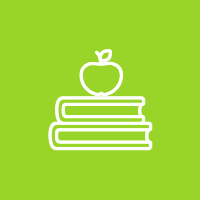Students are often surprised to learn how many different products we get from trees. Use this activity to help your students learn just how much we depend on trees in our daily lives.
This is one of 96 activities that can be found in PLT’s PreK-8 Environmental Education Activity Guide. To get the activity, attend a training either in person or online and receive PLT’s PreK-8 Guide. Below are some supporting resources for this activity.
STUDENT PAGES 
Download the copyright-free student pages that are included with this activity:
Tree Readings
(PDF)
Spanish Student Page(s):
Lecturas del Arbol
(PDF)
RECOMMENDED READING 
Expand your students’ learning and imaginations. Help students meet their reading goals, while building upon concepts learned in this activity, with the following children’s book recommendations:
FAMILY ACTIVITY 
Try a simple variation of this activity to engage children in the outdoors at home. Download this fun and easy-to-do family activity.
ADDITIONAL RESOURCES 
The following tools and resources may be used to enhance the activity.
-
Climate Challenge Board Game
Games4Sustainability can help you incorporate a sustainability-themed game in your activities to improve your understanding of important global issues today. Narrow your search from among 100+ games and simulations by filtering the games by the UN Sustainable Development Goals or use the advanced search for more options. Challenges include topics of food, climate, security, and public health. For example, in the Climate Challenge, players face the crucial trade-off between long-term sustainability and short-term economic growth. Provide your students with a unique challenge to problem solve and practice decision making.
-
Forest Fact Break: Urban Forests
These three 2-minute videos highlight elements of an urban forest, how they’re managed, and the community benefits. More than 80% of all Americans live in urban areas and urban forests bring important benefits to those communities. Developed by forestinfo.org and the North Carolina Forest Service, these Forest Fact Breaks are a great way to help learn more about the following topics: Urban Forests, Urban Forest Benefits, and Urban Forest Wood Usage.
-
Junior Ranger Activity Book
In 2016, the National Park Service (NPS) celebrated a milestone birthday, 100 years! In celebration of its centennial, NPS created the Centennial Junior Ranger Activity Book. Explore the history of the National Park Service and complete fun activities with this printable book. While this book is geared for 4th-grade students, all are welcome to enjoy it.
-
What’s a Tree Done for You Lately?
Products from trees are all around us. Some items are easy to recognize as products we get from trees – lumber, plywood, and paper, for example. Other items such as cellophane, a rayon scarf, and a chocolate bar, may not be as easy to recognize as a product from trees. This publication from Oregon State University will help educators teach students about the variety of products we obtain from trees and how the products are made.
-
Tree Product Images
Print out pages containing many examples of everyday products from trees!
-
Discover the Forest
A program of the Ad Council and U.S. Forest Service, Discover the Forest offers resources that help families discover nearby forests and provides tips on how to prepare for and enjoy outdoor adventures.
-
Product Life Cycle Assessment Worksheet
TeachEngineering offers a basic life cycle assessment method that assigns fictional values for different steps in a product’s life cycle. Students can complete a product analysis using this worksheet and then compare product impacts, and brainstorm ways to reduce unwanted environmental effects.
-
Into the Outdoors – Forest Ecology
Into the Outdoors is an Emmy award-winning TV show with an emphasis on science education for middle school-aged students. The show’s new website, intotheoutdoors.org, provides free videos and other resource links on many environmental topics to make outdoor learning exciting and fun. While there are many exciting topics to choose from (such as sustainable forestry, biodiversity, and wetlands), Into the Outdoor’s 4-part video series on Forest Ecology is a perfect fit with many Project Learning Tree activities. These 5-7 minute shorts feature middle school-aged youth that inspire all of us to take learning outdoors!
-
Gourmet Lab
This free, and downloadable book from the National Science Teachers Association entitled, “Gourmet Lab: The Scientific Principals Behind Your Favorite Foods,” gives students the opportunity to discover science concepts and learn experimental design skills through interactions with everyday foods. Targeting students in grade 6-12, Gourmet Lab offers lots of ideas for science teachers to take on the role of scientist and chef as they boil, bake, and toast their way to better understanding science concepts.
-
FAO’s Global Forest Resources Assessment
The Food and Agriculture Organization of the United Nations (FAO) has monitored the world’s forests at 5 to 10 year intervals since 1946. The State of the World’s Forests 2020–Forests, Biodiversity and People, examines the contributions of forests, and of the people who use and manage them, to the conservation and sustainable use of biodiversity. For the first time, this edition is a joint effort between two United Nations entities: FAO and the United Nations Environment Programme (UNEP).
In addition, this interactive report contains the main findings of the Global Forest Resources Assessment 2020 (FRA 2020). FRA 2020 examines the status of, and trends in, more than 60 forest-related variables in 236 countries and territories in the period 1990–2020. The information provided by FRA presents a comprehensive view of the world’s forests and the ways in which the resource is changing. Such a clear global picture supports the development of sound policies, practices and investments affecting forests and forestry.
The 2015 FRA examined the status and trends at the time for more than 90 variables and all types of forests in 233 countries and areas.
-
Fruit and Vegetable Fact Sheets
These fact sheets from the University of Nebraska-Lincoln Extension’s Nutrition Education Program provide information about 30 fruits and vegetables. Each fact sheet includes an illustration of the fruit or vegetable along with nutrition information, uses, description, varieties, and where the fruit or vegetable was first cultivated. The sheets could be incorporated into K-12 biology, health, or nutrition lessons or shared with students’ families to help promote healthy eating habits.
-
Greener Blue Jeans
Who doesn’t like blue jeans? The indigo dye that provides their distinctive color holds up to detergents, but ages into that soft, worn look. Indigo is one of the oldest dyes used for coloring textiles. For thousands of years it was extracted from tropical plants in Asia, the Middle East and the Americas, with various unpleasant side effects. This Berkeley University of California article describes the research involved in finding a cleaner route to produce the iconic dye.


